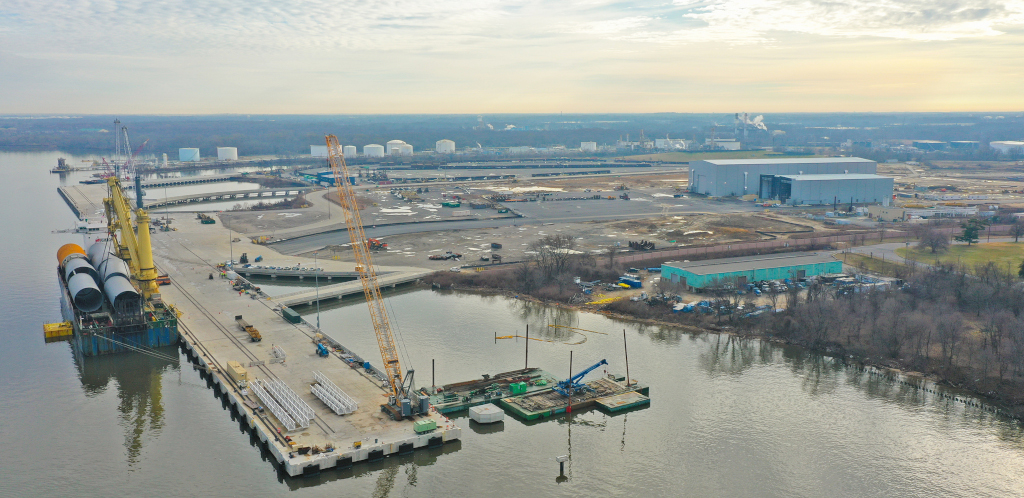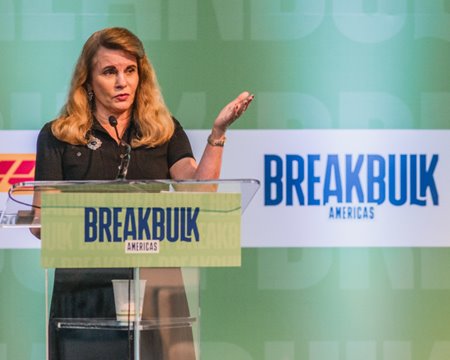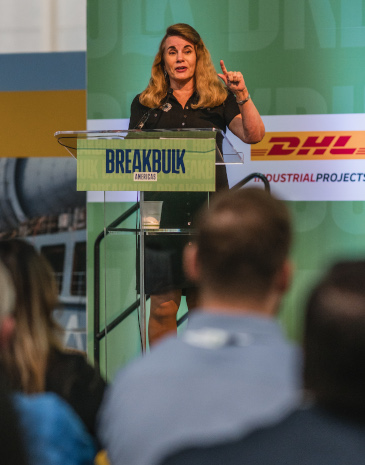Nearly 100 Vessels Needed to Meet Project Pipeline – Melanie Kenderdine, EFI

By Carly Fields
The U.S. energy transition will require billions in investment for ports, vessels, manufacturing, and more, while driving demand for critical minerals within the country’s borders, said Melanie Kenderdine, Principal – Vice President for the Energy Futures Initiative, during her keynote speech at Breakbulk Americas 2023.
Melanie Kenderdine, principal and executive vice president of the Energy Futures Initiative, delivered a keynote speech at Breakbulk Americas that shed light on the evolving landscape of U.S. energy markets and the imperative of developing a world-scale offshore wind sector.
She discussed critical aspects of the energy transition, such as greenhouse gas emissions, renewable portfolio standards, and the offshore wind industry’s growth and potential.
 Kenderdine kicked off her presentation by emphasizing the importance of understanding greenhouse gas emissions, with a particular focus on carbon dioxide (CO2) and methane (CH4). While methane has gained considerable attention, she argued that its impact might be overrated due to its relatively short atmospheric lifespan of 10-12 years. In contrast, CO2 can persist for thousands of years, accumulating with each passing year. Kenderdine’s message was clear: tackling CO2 emissions should be a top priority for mitigating climate change.
Kenderdine kicked off her presentation by emphasizing the importance of understanding greenhouse gas emissions, with a particular focus on carbon dioxide (CO2) and methane (CH4). While methane has gained considerable attention, she argued that its impact might be overrated due to its relatively short atmospheric lifespan of 10-12 years. In contrast, CO2 can persist for thousands of years, accumulating with each passing year. Kenderdine’s message was clear: tackling CO2 emissions should be a top priority for mitigating climate change.
Kenderdine presented a breakdown of U.S. greenhouse gas emissions by sector. Notably, transportation and electricity were the leading contributors, responsible for 27 percent and 25 percent of emissions, respectively. Comparing this with global statistics, the U.S. places a significant emphasis on transportation emissions, with a higher percentage than the rest of the world. Consequently, the rise of electric vehicles in the U.S. holds immense importance.
Conversely, power generation emissions in the U.S. were relatively lower than the global average, accounting for 25 percent of emissions compared with 35 percent worldwide. This led Kenderdine to underscore the significance of renewable energy, especially offshore wind, in reducing emissions and transforming the U.S. energy landscape.
Global Net Zero Targets
Kenderdine highlighted the global shift towards net-zero emissions, with 128 countries and self-governing territories setting ambitious climate targets in 2022. Notably, 60 percent of the world’s countries are committed to achieving net zero. This trend is mirrored in the corporate sector, with 702 publicly listed companies from the Forbes Global 2000 also adopting net-zero targets. Investors are closely monitoring these commitments, and governments worldwide are introducing policies to support them, including offshore wind initiatives.
 Offshore wind was put forward as a key driver in achieving these net-zero goals by Kenderdine. She highlighted the development of renewable portfolio standards in U.S. states, especially in regions along the coast and in the Great Lakes area. These standards and commitments reflect the urgent need to transition to clean energy sources. By 2040, these standards could drive the installation of a massive 42,730 megawatts of offshore wind capacity, transforming the energy landscape.
Offshore wind was put forward as a key driver in achieving these net-zero goals by Kenderdine. She highlighted the development of renewable portfolio standards in U.S. states, especially in regions along the coast and in the Great Lakes area. These standards and commitments reflect the urgent need to transition to clean energy sources. By 2040, these standards could drive the installation of a massive 42,730 megawatts of offshore wind capacity, transforming the energy landscape.
Detailing the advantages of offshore wind over other renewable sources, Kenderdine noted that offshore wind boasts a higher capacity factor compared with solar and onshore wind. The capacity factor for offshore wind is around 45 percent, ensuring a more reliable source of energy.
Using the example of space-constrained New England, Kenderdine examined how much wind and solar would be needed to replace the region’s oil, gas, and nuclear generation.
“I wanted to know, based on the capacity factors, what would I have to do to replace all of the nuclear, gas, and oil generation with 100 percent solar PV with a capacity factor of 24.5 percent. I would need 59,826 megawatts of generation capacity, and I would need 57 square miles for that, while 194 square miles would be needed for onshore wind generation capacity to replace nuclear, gas, and oil.”
With limited space to accommodate that onshore wind capacity, Kenderdine turned to offshore wind with a 45 percent capacity factor. “For the same capacity you’re installing, you’re getting a lot more actual generation. That’s an important point: in a space-constrained region, you can do it offshore. You would need 2,183 wind turbines out there and that’s huge, but it’s important for a region like New England where you don’t have space.”
US Offshore Wind Pipeline
In an overview of the U.S. offshore wind pipeline, Kenderdine highlighted states like New Jersey, New York, Massachusetts, California, North Carolina, and Delaware, which have taken substantial steps in offshore wind development, with a combined capacity of 24,596 megawatts that are under site control. These states are paving the way for a future powered by offshore wind.
“There’s a huge amount of activity moving towards offshore wind – it’s very, very significant,” she said. The total onshore and offshore wind-generated capacity in 2021 in the entire U.S. was 133,000 megawatts; the total offshore wind generation capacity approved, permitted, or under site control – so very advanced in the process – stands at 26,674 megawatts. “That’s 35 percent of the total onshore and offshore wind generation that already exists,” she said.
To support this growth, Kenderdine stressed the critical need for developing infrastructure. This includes marshalling ports, manufacturing facilities and a robust domestic supply chain. Her figures pointed to the requirement for at least 34 new manufacturing facilities, an investment of over US$11 billion in marshalling ports, and substantial resources for deployment. These developments are poised to create thousands of jobs and foster U.S. economic growth.
“For marshalling ports for offshore wind, you need a huge, huge amount of space and weight, load, and protection,” she said. “The manufacturing ports, again, are very important – we need to be manufacturing close to the ports because you can’t transport these wind turbines that are as tall as the Eiffel Tower.”
To deploy the planned offshore wind pipeline in the U.S. will require 2,100 wind turbines, 6,800 miles of cables, 4 to 6 installation vessels, 2,100 foundations, 58 crew transfer vessels, 4 cable lay vessels, 11 service operation vessels, 11 service operation vessels, 4 to 8 transport vessels and 12,300 to 49,000 jobs. “We need 87 to 99 vessels alone to meet the 30 gigawatts by 2030,” she concluded.
TOP PHOTO: Paulsboro Marine Terminal, South Jersey Port. CREDIT: South Jersey
INSERTS: Kenderdine at Breakbulk Americas. CREDIT: Hyve
